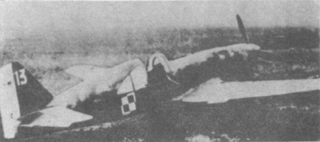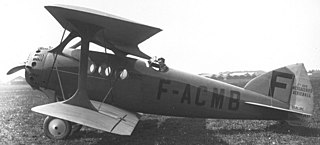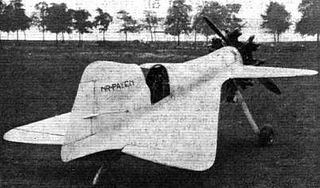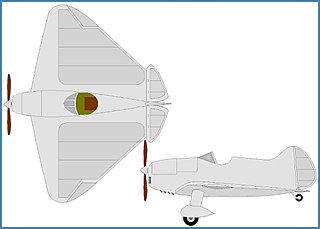
The C.710 were a series of light fighter aircraft developed by Caudron-Renault for the French Air Force just prior to the start of World War II. One version, the C.714, saw limited production, and were assigned to Polish pilots flying in France after the fall of Poland in 1939. A small number was also supplied to Finland.

The Farman F.220 and its derivatives were thick-sectioned, high-winged, four engined French monoplanes from Farman Aviation Works. Based on the push-pull configuration proven by the F.211, design started in August 1925 and the first flight of the prototype was on 26 May 1932. The largest bomber to serve in France between the two world wars was the final F.222 variant. One variation was intended to be an airliner.

Potez 25 was a French twin-seat, single-engine sesquiplane designed during the 1920s. A multi-purpose fighter-bomber, it was designed as a line aircraft and used in a variety of roles, including fighter and escort missions, tactical bombing and reconnaissance missions. In the late 1920s and early 1930s, Potez 25 was the standard multi-purpose aircraft of over 20 air forces, including French and Polish. It was also popular among private operators, notably mail transport companies.

The Morane-Saulnier M.S.225 was a French fighter aircraft of the 1930s. It was produced in limited quantities to be used as a transitional aircraft between the last of the biplanes and the first monoplane fighters.

The Bleriot-SPAD S.33 was a small French airliner developed soon after World War I. The aircraft was a biplane of conventional configuration whose design owed much to the Blériot company's contemporary fighter designs such as the S.20. Four passengers could be accommodated in an enclosed cabin within the monocoque fuselage, and a fifth passenger could ride in the open cockpit beside the pilot. A great success, the S.33 dominated its field throughout the 1920s, initially on CMA's Paris-London route, and later on continental routes serviced by Franco-Roumaine.

The Blériot-SPAD S.61 was a French fighter aircraft developed in 1923. Designed by André Herbemont, the S.61 was a conventional biplane, abandoning the swept upper wing used by Herbemont in several previous designs. The prototype S.61 was evaluated by the French Air Force alongside the S.51 as a potential new fighter, but like its stablemate, was rejected. The Polish Air Force was impressed enough to order 250, as well as purchase licences for local production. The Romanian Air Force also ordered 100 aircraft. About 30 were built in Poland, by the CWL.

The Dewoitine D.332 was an eight-passenger airliner designed and built by the French aircraft manufacturer Dewoitine.

The CAMS 37 was a French 1920s biplane flying boat designed for military reconnaissance, but which found use in a wide variety of roles.

The Caudron C.109 was a light utility aircraft built in France in the late 1920s.

The Farman F.190 was a utility aircraft built in France in the 1920s and 1930s. It was a high-wing, strut-braced monoplane of conventional configuration with a fully enclosed cabin and fixed, tailskid undercarriage. Popular both as a private aircraft and in the air taxi role, some 30 examples were also operated by airlines in France and elsewhere in Europe. Fifteen of these joined Air France's fleet in 1933 from the fleets of the smaller airlines it had absorbed.

The Farman F.300 and F.310 were trimotor monoplane airliners designed and produced by the French aircraft manufacturer Farman Aviation Works.

The Bratu-220 was a Franco-Romanian prototype three-engined airliner of the 1930s, built in France.

The Lioré et Olivier H-190 was a biplane flying boat aircraft designed and produced by the French aircraft manufacturer Lioré et Olivier.

The Potez 75 was a low-cost, simple, ground-support, observation and launch aircraft for anti-tank missiles, designed and built in the early 1950s, for use in colonial conflicts. One hundred and fifteen were ordered in 1956, but cancelled in 1957.

The SAB AB-20 was a large four engine twin boom French bomber built in the early 1930s as a development of the Dyle et Bacalan DB-70 airliner. It featured a lifting body of thick airfoil section between the inner engines. It was later modified for the attack role; a second aircraft, the AB-21, had different engines and cleaner aerodynamics but no more were built.

The Loire 250 was a French single-seat fighter monoplane designed and built by Loire Aviation of St. Nazaire.
The Bernard 80 GR was one of three types built by different French constructors in response to a government call for an aircraft capable of setting new long-distance records. A single engine monoplane with a crew of two, the 80 GR set an absolute record for flight over a closed circuit in April 1931, covering 8,960 km (5,569 mi). Modifications led to a new designation as the Bernard 81 GR but no more records were set despite several attempts.

The Payen Pa.101 was an experimental aircraft designed by Nicolas Roland Payen in the 1930s.

The Payen or Aubrun-Payen AP.10 was an experimental aircraft designed and built in collaboration with Nicolas Roland Payen in the 1930s.
The SNCAC NC.271 was a French experimental aircraft built by SNCAC in the late 1940s, as a 1:2.5 scale model of the proposed SNCAC NC.270 jet bomber, featuring swept-back wings, using SNCASE SE-161 Languedoc N0.31 F-BCUT as a launch platform.



















